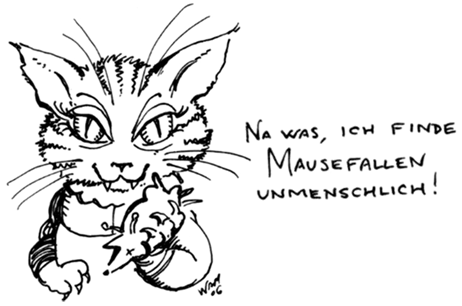2.3.2.2: present regular verbs
- Page ID
- 105399
Verbs are used to describe actions. The present tense is used to describe actions that are going on right now or events that regularly happen.
| Der Esel macht Kaffee für seine Mitbewohner. | The donkey makes coffee for his room mates. |
| Sie trinken jeden Tag fast zwei Liter. | They drink almost two liters every day. |
Unlike English, German does not use a different form of the verb to describe events that are in progress right now (present progressive in English: The donkey is sitting at the table) and events that happen regularly (present tense in English: He sits at the table every morning.).
| Der Esel singt. | The donkey is singing. |
| Er repariert die Wände im Bad. | He is repairing the walls in the bathroom. |
| Der Hund kommt nach Hause. | The dog comes home. |
| Er geht in die Küche; er sucht die Katze. | He goes into the kitchen; he is looking for the cat. |
You can say that something is happening right now by adding some expressions to your sentence:
| gerade | right now |
| im Moment | at the moment |
| zur Zeit | at this time |
| Die Katze ist zur Zeit nicht zu Hause. Sie jagt im Moment zwei Mäuse. | The cat is not at home at this time. She is chasing two mice at the moment. |
| Die Katze ist alt, und die Mäuse laufen gerade weg und lachen sie aus. Arme Katze! | The cat is old, and the mice are running away from her and are laughing at her. Poor cat! |

Verb conjugations – regular verbs
In the present tense, verbs can be either regular or irregular (just to keep you on your toes, some verbs may be irregular in the present tense but not in the past, others may be irregular in the past tense but not in the present). Regular verbs add endings to the stem of the verb, irregular verbs add endings and change the vowel of the stem.
Regular verbs
The verb stem of regular verbs stays intact, and you add the personal endings to this stem:
| spielen • play | |
| ich spiele | wir spielen |
| du spielst | ihr spielt |
| er/sie/es spielt | sie spielen |
If the stem ends in d or t, you add an extra -e before some endings:
| arbeiten • work | |
| ich arbeite | wir arbeiten |
| du arbeitest | ihr arbeitet |
| er/sie/es arbeitet | sie arbeiten |
| finden • find | |
| ich finde | wir finden |
| du findest | ihr findet |
| er/sie/es findet | sie finden |
| der Hahn | Warum spielst du mit diesen Mäusen? | Why are you playing with these mice? |
| die Katze | Ich spiele nicht. Ich arbeite. | I am not playing. I am working. |
| der Hahn | Warum kaufst du keine Mausefallen? | Why don't you buy mousetraps? |
| die Katze | He, ich finde Mausefallen unmenschlich! | Hey, I find mousetraps inhumane! |
| der Hahn | Ich nicht! | Well, I don't! |
| die Katze | Gut für dich! | Good for you! |

When you are talking formally, with adults you don't know, you need to use Sie. With Sie you need to use verbs in the same form as the third person plural:
| Es klopft an der Tür. | There is a knock on the door. | |
| Die alte Hexe ist verärgert |
Frau Katze, Sie arbeiten nicht genug. Ich finde jeden Tag immer mehr Mäuse in meiner Speisekammer. | Ms. Cat, you don't work enough. I find more and more mice in my pantry every day. |
| der Hahn | Sie finden so viele Mäuse, weil Sie Ihre Speisekammer nie putzen. Sie Dreckspatz! | You find so many mice because you never clean your pantry. |
| die alte Hexe | Naja, mein Zauberbesen ist im Moment kaputt, aber trotzdem ... | Well, my magic broom is broken at the moment, but still ... |
| der Hahn | Hmmm ... ich hau ab. | I'm outta here. |
| die Katze | Hexen ... sie arbeiten nicht mehr. Sie schlafen den ganzen Tag! und beschweren sich dann über uns arme Katzen! | Witches ... they don't work anymore. They sleep the whole day away! Then they complain about us, poor cats! |
| Und die Tiere machen die Tür zu, bevor die alte Hexe noch etwas sagt ... | And the animals close the door before the old witch says anything else ... |


